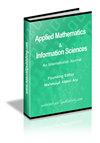{"title":"基于粒子群优化方法的德国SARS-CoV-2感染SEIRD模型参数估计","authors":"E. A. Nakajima, A. Ignacio, D. Lange, E. Izumi","doi":"10.18576/amis/150403","DOIUrl":null,"url":null,"abstract":"The present paper describes a particle swarm optimization (PSO) method used to estimate parameters of a Susceptible-Exposed-Infected-Recovered-Dead (SEIRD) model applied to predict SARS-CoV-2 transmission in Germany, based on data from February 15th to April 25th, 2020, considering that the lockdown in the country started on March 23rd. The model estimated patients' mortality (4.92%) and recovery rates (95.08%), virus incubation (8.54 days), infection periods (18.65 days), as well as the basic virus reproduction number before (R0 = 11.60) and after (R0 = 0.39) lockdown. The predicted values were accurate until the 70th day. The performances achieved by the model were 0.98 for infected, 0.97 for the recovered and 0.97 for the dead, asserting the model's great performance (>0.75). The model also suggests that on February 15th, 2020, there were 67 infected individuals in the incubation period. We believe that this model can help other studies to better understand and accurately predict epidemic curves, mainly in countries where the new coronavirus has recently started to spread. It also may guide public health policies that aim to control the disease. © 2021 NSP Natural Sciences Publishing Cor. All Rights Reserved.","PeriodicalId":49266,"journal":{"name":"Applied Mathematics & Information Sciences","volume":" ","pages":""},"PeriodicalIF":0.0000,"publicationDate":"2021-07-01","publicationTypes":"Journal Article","fieldsOfStudy":null,"isOpenAccess":false,"openAccessPdf":"","citationCount":"1","resultStr":"{\"title\":\"Estimating Parameters of a SEIRD Model Applied to SARS-CoV-2 Infections in Germany based on the Particle Swarm Optimization Method\",\"authors\":\"E. A. Nakajima, A. Ignacio, D. Lange, E. Izumi\",\"doi\":\"10.18576/amis/150403\",\"DOIUrl\":null,\"url\":null,\"abstract\":\"The present paper describes a particle swarm optimization (PSO) method used to estimate parameters of a Susceptible-Exposed-Infected-Recovered-Dead (SEIRD) model applied to predict SARS-CoV-2 transmission in Germany, based on data from February 15th to April 25th, 2020, considering that the lockdown in the country started on March 23rd. The model estimated patients' mortality (4.92%) and recovery rates (95.08%), virus incubation (8.54 days), infection periods (18.65 days), as well as the basic virus reproduction number before (R0 = 11.60) and after (R0 = 0.39) lockdown. The predicted values were accurate until the 70th day. The performances achieved by the model were 0.98 for infected, 0.97 for the recovered and 0.97 for the dead, asserting the model's great performance (>0.75). The model also suggests that on February 15th, 2020, there were 67 infected individuals in the incubation period. We believe that this model can help other studies to better understand and accurately predict epidemic curves, mainly in countries where the new coronavirus has recently started to spread. It also may guide public health policies that aim to control the disease. © 2021 NSP Natural Sciences Publishing Cor. All Rights Reserved.\",\"PeriodicalId\":49266,\"journal\":{\"name\":\"Applied Mathematics & Information Sciences\",\"volume\":\" \",\"pages\":\"\"},\"PeriodicalIF\":0.0000,\"publicationDate\":\"2021-07-01\",\"publicationTypes\":\"Journal Article\",\"fieldsOfStudy\":null,\"isOpenAccess\":false,\"openAccessPdf\":\"\",\"citationCount\":\"1\",\"resultStr\":null,\"platform\":\"Semanticscholar\",\"paperid\":null,\"PeriodicalName\":\"Applied Mathematics & Information Sciences\",\"FirstCategoryId\":\"1085\",\"ListUrlMain\":\"https://doi.org/10.18576/amis/150403\",\"RegionNum\":0,\"RegionCategory\":null,\"ArticlePicture\":[],\"TitleCN\":null,\"AbstractTextCN\":null,\"PMCID\":null,\"EPubDate\":\"\",\"PubModel\":\"\",\"JCR\":\"Q2\",\"JCRName\":\"Mathematics\",\"Score\":null,\"Total\":0}","platform":"Semanticscholar","paperid":null,"PeriodicalName":"Applied Mathematics & Information Sciences","FirstCategoryId":"1085","ListUrlMain":"https://doi.org/10.18576/amis/150403","RegionNum":0,"RegionCategory":null,"ArticlePicture":[],"TitleCN":null,"AbstractTextCN":null,"PMCID":null,"EPubDate":"","PubModel":"","JCR":"Q2","JCRName":"Mathematics","Score":null,"Total":0}
引用次数: 1
Estimating Parameters of a SEIRD Model Applied to SARS-CoV-2 Infections in Germany based on the Particle Swarm Optimization Method
The present paper describes a particle swarm optimization (PSO) method used to estimate parameters of a Susceptible-Exposed-Infected-Recovered-Dead (SEIRD) model applied to predict SARS-CoV-2 transmission in Germany, based on data from February 15th to April 25th, 2020, considering that the lockdown in the country started on March 23rd. The model estimated patients' mortality (4.92%) and recovery rates (95.08%), virus incubation (8.54 days), infection periods (18.65 days), as well as the basic virus reproduction number before (R0 = 11.60) and after (R0 = 0.39) lockdown. The predicted values were accurate until the 70th day. The performances achieved by the model were 0.98 for infected, 0.97 for the recovered and 0.97 for the dead, asserting the model's great performance (>0.75). The model also suggests that on February 15th, 2020, there were 67 infected individuals in the incubation period. We believe that this model can help other studies to better understand and accurately predict epidemic curves, mainly in countries where the new coronavirus has recently started to spread. It also may guide public health policies that aim to control the disease. © 2021 NSP Natural Sciences Publishing Cor. All Rights Reserved.


